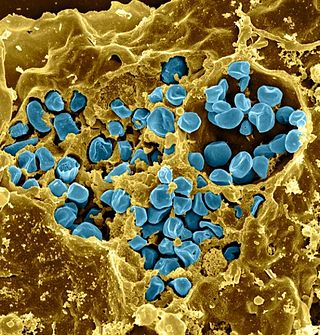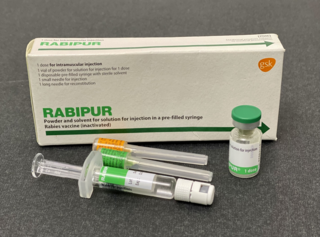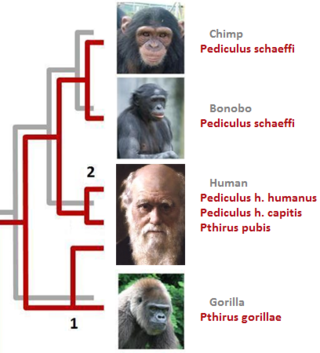Related Research Articles

Myxomatosis is a disease caused by Myxoma virus, a poxvirus in the genus Leporipoxvirus. The natural hosts are tapeti in South and Central America, and brush rabbits in North America. The myxoma virus causes only a mild disease in these species, but causes a severe and usually fatal disease in European rabbits.
Virulence is a pathogen's or microorganism's ability to cause damage to a host.

Avian influenza, also known as avian flu, is a bird flu caused by the influenza A virus, which can infect people. It is similar to other types of animal flu in that it is caused by a virus strain that has adapted to a specific host. The type with the greatest risk is highly pathogenic avian influenza (HPAI).

Influenza A virus subtype H5N1 (A/H5N1) is a subtype of the influenza A virus which can cause illness in humans and many other species. A bird-adapted strain of H5N1, called HPAI A(H5N1) for highly pathogenic avian influenza virus of type A of subtype H5N1, is the highly pathogenic causative agent of H5N1 flu, commonly known as avian influenza. It is enzootic in many bird populations, especially in Southeast Asia. One strain of HPAI A(H5N1) is spreading globally after first appearing in Asia. It is epizootic and panzootic, killing tens of millions of birds and spurring the culling of hundreds of millions of others to stem its spread. Many references to "bird flu" and H5N1 in the popular media refer to this strain.

Francisella tularensis is a pathogenic species of Gram-negative coccobacillus, an aerobic bacterium. It is nonspore-forming, nonmotile, and the causative agent of tularemia, the pneumonic form of which is often lethal without treatment. It is a fastidious, facultative intracellular bacterium, which requires cysteine for growth. Due to its low infectious dose, ease of spread by aerosol, and high virulence, F. tularensis is classified as a Tier 1 Select Agent by the U.S. government, along with other potential agents of bioterrorism such as Yersinia pestis, Bacillus anthracis, and Ebola virus. When found in nature, Francisella tularensis can survive for several weeks at low temperatures in animal carcasses, soil, and water. In the laboratory, F. tularensis appears as small rods, and is grown best at 35–37 °C.
An emergent virus is a virus that is either newly appeared, notably increasing in incidence/geographic range or has the potential to increase in the near future. Emergent viruses are a leading cause of emerging infectious diseases and raise public health challenges globally, given their potential to cause outbreaks of disease which can lead to epidemics and pandemics. As well as causing disease, emergent viruses can also have severe economic implications. Recent examples include the SARS-related coronaviruses, which have caused the 2002-2004 outbreak of SARS (SARS-CoV-1) and the 2019–21 pandemic of COVID-19 (SARS-CoV-2). Other examples include the human immunodeficiency virus which causes HIV/AIDS; the viruses responsible for Ebola; the H5N1 influenza virus responsible for avian flu; and H1N1/09, which caused the 2009 swine flu pandemic. Viral emergence in humans is often a consequence of zoonosis, which involves a cross-species jump of a viral disease into humans from other animals. As zoonotic viruses exist in animal reservoirs, they are much more difficult to eradicate and can therefore establish persistent infections in human populations.

H5N1 genetic structure is the molecular structure of the H5N1 virus's RNA.
Aujeszky's disease, usually called pseudorabies in the United States, is a viral disease in swine that is endemic in most parts of the world. It is caused by Suid herpesvirus 1 (SuHV-1). Aujeszky's disease is considered to be the most economically important viral disease of swine in areas where classical swine fever has been eradicated. Other mammals, such as cattle, sheep, goats, cats, dogs, and raccoons, are also susceptible. The disease is usually fatal in these animal species.

Feline calicivirus (FCV) is a virus of the family Caliciviridae that causes disease in cats. It is one of the two important viral causes of respiratory infection in cats, the other being Felid alphaherpesvirus 1. FCV can be isolated from about 50% of cats with upper respiratory infections. Cheetahs are the other species of the family Felidae known to become infected naturally.
The NS1 influenza protein (NS1) is a viral nonstructural protein encoded by the NS gene segments of type A, B and C influenza viruses. Also encoded by this segment is the nuclear export protein (NEP), formally referred to as NS2 protein, which mediates the export of influenza virus ribonucleoprotein (RNP) complexes from the nucleus, where they are assembled.

Human mortality from H5N1 or the human fatality ratio from H5N1 or the case-fatality rate of H5N1 is the ratio of the number of confirmed human deaths resulting from confirmed cases of transmission and infection of H5N1 to the number of those confirmed cases. For example, if there are 100 confirmed cases of humans infected with H5N1 and 10 die, then there is a 10% human fatality ratio. H5N1 flu is a concern due to the global spread of H5N1 that constitutes a pandemic threat. The majority of H5N1 flu cases have been reported in southeast and east Asia. The case-fatality rate is central to pandemic planning. Estimates of case-fatality (CF) rates for past influenza pandemics have ranged from to 2-3% for the 1918 pandemic to about 0.6% for the 1957 pandemic to 0.2% for the 1968 pandemic. As of 2008, the official World Health Organization estimate for the case-fatality rate for the outbreak of H5N1 avian influenza was approximately 60%. Public health officials in Ontario, Canada argue that the true case-fatality rate could be lower, pointing to studies suggesting it could be 14-33%, and warned that it was unlikely to be as low as the 0.1–0.4% rate that was built into many pandemic plans.
An attenuated vaccine is a vaccine created by reducing the virulence of a pathogen, but still keeping it viable. Attenuation takes an infectious agent and alters it so that it becomes harmless or less virulent. These vaccines contrast to those produced by "killing" the pathogen.

The rabies vaccine is a vaccine used to prevent rabies. There are several rabies vaccines available that are both safe and effective. Vaccinations must be administered prior to rabies virus exposure or within the latent period after exposure to prevent the disease. Transmission of rabies virus to humans typically occurs through a bite or scratch from an infectious animal, but exposure can occur through indirect contact with the saliva from an infectious individual.
The French Louis Pasteur (1822–1895) and German Robert Koch (1843–1910) are the two greatest figures in medical microbiology and in establishing acceptance of the germ theory of disease. In 1882, fueled by national rivalry and a language barrier, the tension between Pasteur and the younger Koch erupted into an acute conflict.
Porcine epidemic diarrhea is a condition caused by the porcine epidemic diarrhea virus that leads to severe gastrointestinal disease in pigs.
This glossary of virology is a list of definitions of terms and concepts used in virology, the study of viruses, particularly in the description of viruses and their actions. Related fields include microbiology, molecular biology, and genetics.
Biotechnology risk is a form of existential risk from biological sources, such as genetically engineered biological agents. The release of such high-consequence pathogens could be

In parasitology and epidemiology, a host switch is an evolutionary change of the host specificity of a parasite or pathogen. For example, the human immunodeficiency virus used to infect and circulate in non-human primates in West-central Africa, but switched to humans in the early 20th century.

Animal vaccination is the immunisation of a domestic, livestock or wild animal. The practice is connected to veterinary medicine. The first animal vaccine invented was for chicken cholera in 1879 by Louis Pasteur. The production of such vaccines encounter issues in relation to the economic difficulties of individuals, the government and companies. Regulation of animal vaccinations is less compared to the regulations of human vaccinations. Vaccines are categorised into conventional and next generation vaccines. Animal vaccines have been found to be the most cost effective and sustainable methods of controlling infectious veterinary diseases. In 2017, the veterinary vaccine industry was valued at US$7 billion and it is predicted to reach US$9 billion in 2024.
Gain-of-function research is medical research that genetically alters an organism in a way that may enhance the biological functions of gene products. This may include an altered pathogenesis, transmissibility, or host range, i.e., the types of hosts that a microorganism can infect. This research is intended to reveal targets to better predict emerging infectious diseases and to develop vaccines and therapeutics. For example, influenza B can infect only humans and harbor seals. Introducing a mutation that would allow influenza B to infect rabbits in a controlled laboratory situation would be considered a gain-of-function experiment, as the virus did not previously have that function. That type of experiment could then help reveal which parts of the virus's genome correspond to the species that it can infect, enabling the creation of antiviral medicines which block this function.
References
- ↑ "Serial passage". Biology online. Retrieved 16 April 2014.
- ↑ Herfst S, Schrauwen EJ, Linster M, Chutinimitkul S, de Wit E, Munster VJ, et al. (2012). "Airborne transmission of influenza A/H5N1 virus between ferrets". Science. 336 (6088): 1534–41. Bibcode:2012Sci...336.1534H. doi:10.1126/science.1213362. PMC 4810786 . PMID 22723413.
{{cite journal}}: CS1 maint: multiple names: authors list (link) - ↑ Chapuis É, Pagès S, Emelianoff V, Givaudan A, Ferdy JB (January 2011). "Virulence and pathogen multiplication: a serial passage experiment in the hypervirulent bacterial insect-pathogen Xenorhabdus nematophila". PLOS ONE. 6 (1): e15872. Bibcode:2011PLoSO...615872C. doi: 10.1371/journal.pone.0015872 . PMC 3031541 . PMID 21305003.
- ↑ Somerville GA, Beres SB, Fitzgerald JR, DeLeo FR, Cole RL, Hoff JS, Musser JM (March 2002). "In vitro serial passage of Staphylococcus aureus: changes in physiology, virulence factor production, and agr nucleotide sequence". Journal of Bacteriology. 184 (5): 1430–7. doi:10.1128/jb.184.5.1430-1437.2002. PMC 134861 . PMID 11844774.
- 1 2 3 4 5 6 7 Woo HJ, Reifman J (January 2014). "Quantitative modeling of virus evolutionary dynamics and adaptation in serial passages using empirically inferred fitness landscapes". Journal of Virology. 88 (2): 1039–50. doi:10.1128/JVI.02958-13. PMC 3911671 . PMID 24198414.
- ↑ Martínez JL, Baquero F, Andersson DI (October 2011). "Beyond serial passages: new methods for predicting the emergence of resistance to novel antibiotics". Current Opinion in Pharmacology. 11 (5): 439–45. doi:10.1016/j.coph.2011.07.005. PMID 21835695.
- 1 2 3 4 5 6 7 8 9 10 Smith KA (2012). "Louis pasteur, the father of immunology?". Frontiers in Immunology. 3: 68. doi: 10.3389/fimmu.2012.00068 . PMC 3342039 . PMID 22566949.
- 1 2 3 4 Schwartz, M. (2001). The life and works of Louis Pasteur. Journal of Applied Microbiology, 91 (4), 597-601.
- ↑ McCullers JA (September 2007). "Evolution, benefits, and shortcomings of vaccine management". Journal of Managed Care Pharmacy. 13 (7 Suppl B): S2–6. doi: 10.18553/jmcp.2007.13.s7-b.2a . PMC 10438138 . PMID 17874877.
- ↑ Hunt R. "'Vaccines: past successes and future prospects". Microbiology and Immunology On-line. Retrieved 5 May 2014.
- 1 2 "Types of Vaccines". National Institute of Allergy and Infectious Diseases. Retrieved 5 May 2014.
- 1 2 3 Locher CP, Witt SA, Herndier BG, Abbey NW, Tenner-Racz K, Racz P, Kiviat NB, Murthy KK, Brasky K, Leland M, Levy JA (January 2003). "Increased virus replication and virulence after serial passage of human immunodeficiency virus type 2 in baboons". Journal of Virology. 77 (1): 77–83. doi:10.1128/jvi.77.1.77-83.2003. PMC 140565 . PMID 12477812.
- 1 2 3 4 5 6 7 8 9 10 Zimmer C (2013). "Chapter 15". The Tangled Bank (second ed.). Robert and Co. Publishers. pp. 399–427.
- ↑ Pandey K, Acharya A (2021). "Animal models for SARS-CoV-2 research: A comprehensive literature review". Transboundary and Emerging Diseases (published October 2020). 68 (4): 1868–1885. doi:10.1111/tbed.13907. PMC 8085186 . PMID 33128861.
Gu et. al. also generated a mouse-adapted SARS-CoV-2 from serial passage of human clinical isolate BetaCov/human/CHN/Beijing_IME-BJ05/2020 in aged mice (Gu et al., 2020). [...] Similarly, mouse-adapted SARS-CoV-2 is produced by serial passaging of virus in mouse lungs, which reduces virus potency but on the other hand also increases chances of mutations.
{{cite journal}}: External link in|quote= - 1 2 3 4 Puiu T (3 May 2012). "H5N1 controversial paper shows that bird flu is only a genetic mutation away from mammal flu". ZME Science. Retrieved 26 April 2014.